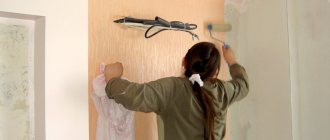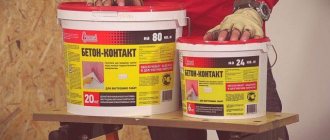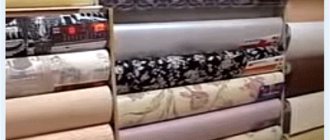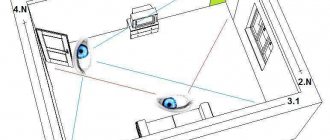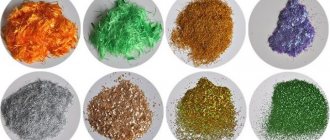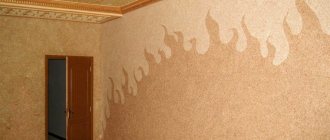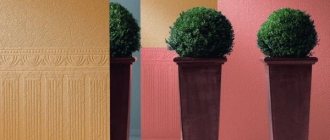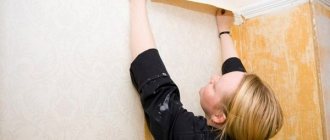Why do you need repair interlining?
Anyone who has been renovating their home has been puzzled by the question: how to prepare the surface of the walls before applying the final finishing coat, be it wallpaper or just acrylic paint.
Usually, a layer of finishing plaster is applied for this, but you need to know how to do this, and this process is also accompanied by an abundance of dust and debris. An alternative to finishing coating, in modern construction, to level the surface of walls and ceilings, is the use of fiberglass or painting non-woven fabric. That’s what we’ll talk about in this article about painting, or in other words, repair non-woven fabric. So, repair non-woven material is an impregnated non-woven material used for decorative finishing of walls and ceilings in all types of premises. Non-woven fabric consists of long-fiber cellulose and synthetic fibers interconnected by polymer materials. The ratio of these components gives the non-woven fabric different characteristics. To give the walls a smooth look, a non-woven fabric is required, in which cellulose predominates. With the predominance of synthetic fibers, the surface of the non-woven fabric is rough and after gluing the relief of the fabric structure appears.
Repair interlining varies in material density - from 65 to 175 g/m²
Advantages of non-woven fabric:
It has an increased (compared to fiberglass) reinforcing effect - it masks cracks, rusts, seams between panels on walls and ceilings, does not allow microcracks to “grow”, and prevents the appearance of network-like cracks on painted surfaces.
Levels and strengthens the surfaces of walls and ceilings before painting, making the surface for painting perfectly smooth and mechanically strong. Significantly reduces paint consumption. Replaces finishing putty before painting. Repair interlining can be glued to all types of plasters, porous concrete, plasterboard, wood, plastic panels, fiberboard and chipboard. Non-woven fabric also adheres well to old wallpaper of any type and old paint, which makes repairing old premises much easier and cheaper.
Recently, environmental friendliness and toxic safety of housing have become increasingly popular. So, in the production of non-woven fabric, most of the raw materials are of natural origin; heavy metals and their compounds, organic solvents, mineral fibers and formaldehydes are not used.
Repair interlining:
- does not contain fiberglass,
- non-toxic,
- does not release harmful substances into the environment.
High antifungal resistance helps it fight mold formation. Thanks to a high degree of vapor permeability, it creates a healthy indoor microclimate.
Pasting a surface with non-woven fabric does not require additional skills and anyone can do it, even if you are doing it for the first time. On the prepared base - the surface must be strong, dry, free of dust and dirt, cracks, irregularities and chips filled with any putty - apply glue for non-woven wallpaper using a roller. It is better if the glue is of the same brand as the interlining (as a rule, manufacturers make the entire line of products). Apply a non-woven canvas, previously cut to size, onto the surface treated with glue. The following canvases are fitted end-to-end, while the seams remain almost invisible. If the sheet does not fit very well, you need to immediately peel it off and re-glue it. You can paint the finished surface after 24 hours with any water-based acrylic or latex paint using a soft fleecy roller (two layers of application) or a spray bottle (about three layers of application). When using dark colors, it is recommended to repaint the paint no more than three times in the future; when painting with pastel colors, it can be repainted more than seven times.
So, let's summarize:
- repair interlining has high strength, does not deform, retains its shape even in conditions of high humidity;
- protects against the formation of cracks during shrinkage of walls in new houses;
- improves sound insulation;
- difficult to ignite;
- has a long service life (up to 25 years);
- can be repainted up to 7 times;
- easy to use;
- It can be easily removed without leaving any traces.
Using repair non-woven fabric, you keep up with the times!
Did you know that
When choosing a modern repair interlining (also called painting or construction) as a finishing material for painting, you need to take into account some features, or more precisely:
- The first and most important aspect is the choice of repair non-woven fabric. Some unscrupulous manufacturers save on polyester or polyethylene fibers, leaving cellulose as the base component. The result is high-quality, dense cardboard with the addition of specific fibers, and not repair interlining (perhaps it will suit you as a denser fiberglass). Instructions for use will help you understand in the store that you are looking at cardboard called non-woven fabric or a quality product: if you are advised to apply glue first to the canvas and to the wall, wait a while for absorption, you should know that this canvas is dominated by cellulose. High-quality non-woven interlining is glued to the wall immediately (the glue is applied only to the surface of the wall).
- It is important to choose the right density of the material. For smooth, even walls (ceilings), a density of 80-85 g/m is sufficient, while in the presence of cracks and plane errors, at least 130 is required.
- Then. It is necessary to understand that gluing the canvas still requires a certain skill - the ability to join without a gap and without overlap, just butt to butt (like wallpaper). If the joints are still visible, experienced craftsmen advise additionally covering the surface with an acrylic primer - it will create an even film on the seams and they will be invisible when painting.
- Painting moment. Many years of experience suggest that it is more effective to apply paint with a roller (many finishers recommend façade paint), as if rolling it into the structure - this provides a smooth, glossy surface (when sprayed from a spray bottle, the paint lays down as a top layer, with possible clots and bubbles). As for the number of layers, the optimal coating is considered to be one layer of white paint and the next 2 layers of tinted paint.
Let us remind you! High-quality interlining does not require subsequent putty ; it is an alternative to finishing putty. A material that allows finishing the finishing process in a short time with minimal pollution of the surrounding space.02.24.2016, .Elena 02.15.2019 11:10:06 #
Overview of the main features of the material
To understand the features of working with non-woven coating for painting, you need to understand what this material is and what criteria high-quality samples must meet.
Manufacturing technology
Non-woven paper for painting consists of the following main components:
- The basis is long-fiber cellulose - a durable and reliable material.
- The top layer is made of the finest polyester fibers, thanks to which the surface is so smooth and durable.
- The binding component is a polymer acrylic composition, which gives the coating a lot of positive properties: lack of linear expansion, resistance to humidity and temperature changes and a very long service life.
The surface of the coating resembles a drawing paper, but its structure is much smoother and softer. This coating is suitable for any room, it is completely environmentally friendly and does not emit any harmful substances during operation. That is why it can be used even in children's rooms, kitchens and bathrooms. .
Criterias of choice
High performance properties of this type of finish can only be guaranteed when the material is made from high-quality raw materials and in compliance with numerous standards.
It is quite simple to distinguish a high-quality product from a low-quality one:
- The main indicator of quality is a perfectly smooth, silky structure. Any extraneous inclusions, irregularities and other defects indicate that the product was manufactured in violation of technology. It is from the surface that you should start choosing the optimal option.
- Leading manufacturers pay great attention to the ideal processing of edges, since these are the most problematic areas - flaws and tears significantly worsen the appearance of the surface.
- Another indicator of high quality is the elasticity of the material; if there are traces of bending on it, it is better to choose another sample that is more resistant to damage.
- The composition should not contain any foreign additives. To ensure this, you need to ask the seller to provide a quality certificate. If it is not available, it is better to refuse the purchase, since all products in this group must undergo certification.
- Another important factor is the lack of stretch in any direction. It is very simple to check this; you need to pull any section of the material in different directions; if it is even slightly stretched, its strength is quite low.
Unlike fiberglass, construction non-woven fabric for painting is almost opaque; any visible fibers are a sign of low quality
Advice! It is best to choose products from well-known brands or read reviews about a particular material on construction forums on the Internet. As a rule, the necessary information can be found fairly quickly.
Features of working with non-woven canvas
Working with non-woven canvas Before gluing the canvas, it is necessary to eliminate existing unevenness on the surface of the walls by filling them with acrylic putty.
Gluing non-woven canvas is similar to gluing wallpaper, with some nuances. To begin, prepare the glue strictly according to the instructions. Apply the solution to the surface on which you are going to glue the interlining.
It is more convenient to glue the canvas together, since the sheet must first be applied to the surface as carefully as possible, and then carefully leveled with a spatula. The next sheet is glued side by side, paying special attention to the joints. When gluing non-woven canvases, smooth them with a wallpaper spatula.
After gluing the canvas, it needs to be given about a day to dry, and then primed with any deeply penetrating composition. Next you can start painting. Unlike cullet, non-woven lining does not need to be puttied again after drying. A variety of paints are suitable for painting. Just keep in mind that when painting protruding metal elements, it is better to use fire-resistant paints for metal.
Non-woven fabric is a fire-resistant material. Using it, you don’t have to worry too much about fire safety in the room. In general, this material is suitable for any room, and if handled correctly, the resulting surface should be almost perfectly smooth and even.
How to glue non-woven wallpaper?
Many people are interested in how to hang wallpaper for painting with their own hands and is it even possible?
Gluing non-woven wallpaper does not cause any particular difficulties, so it is quite possible to do it yourself
The process of covering a room with non-woven wallpaper is quite simple. And it is not at all necessary to resort to the help of specialists. You just need to purchase suitable glue, a brush with which to apply it, as well as a special roller, plastic spatula or soft cloth.
Hanging wallpaper for painting with your own hands begins with preparing the working surface. To do this you need:
- remove old finish;
- level the walls using putty;
- prime the surface.
Next, you should prepare glue for non-woven wallpaper in accordance with the instructions, and also cut strips of the required length. To do this, take the required height of the room and add about 5 cm to it. In this case, it is imperative to ensure that the drawing or pattern matches, if any.
Now let's look at how to glue wallpaper for painting on walls.
When smoothing the wallpaper, all movements should occur from the middle to the edges
It is important that the first strip is glued strictly vertically. To do this, use a plumb line or level. Next, apply glue to the surface of the wall (there is no need to cover the canvas itself with adhesive) and attach the strip to it. After this, carefully level the canvases and expel the air from under them using a special roller, brush or soft cloth. All movements are performed from the middle to the edges. There should be no folds or bubbles. After gluing one strip, move on to the next.
Any excess glue that remains on the front side of the canvas must be immediately removed with a rag.
After the walls are pasted over, you need to wait about a day for them to dry completely. At this time, changes in room temperature and drafts should be avoided.
Reduced prices for non-woven canvases
Dear customers!
Prices for the following non-woven canvases are reduced by 15%
Non-woven fabric Walltex PF 65 (1.06*25)
Painting non-woven material is a non-woven material made of cellulose and textile fibers with a polymer binder, similar to fiberglass, but having a finer structure and a smoother surface. Walltex non-woven fabric is a safe and harmless material to use; it does not contain PVC and allows steam to pass through, almost like paper wallpaper.
Non-woven canvas Walltex PF 65 well masks defects and imperfections of surfaces and is an almost perfect base, as for ordinary wallpaper made of paper, vinyl and wallpaper for painting.
Non-woven canvas Walltex WF150 (1.06*25)
Price: 2,208 rub.
This is a non-woven material made from cellulose and textile fibers with polymer bonds, very similar to painter's fiberglass, but with a much finer structure, and as a result, as a rule, the surface has a smoother finish.
Walltex non-woven fabric is a safe and harmless material to use; it does not contain PVC and allows steam to pass through, almost like paper wallpaper.
Non-woven fabric is needed to level ceilings and walls.
Non-woven canvas Walltex WF150 well masks defects and imperfections of surfaces and is an almost perfect base, both for ordinary paper and vinyl wallpaper, and wallpaper for painting.
Non-woven painting "Phoenix Stroy" 80g/m2, 1*25m
Nonwoven painting "Phoenix Stroy" is a non-woven material made of cellulose and textile fibers with polymer bonds, very similar to painting fiberglass, but with a much finer structure, and as a result, as a rule, the surface has a smoother surface. Non-woven fabric is needed to level ceilings and walls. This material masks surface defects and imperfections well and is an almost perfect base for both regular paper and vinyl wallpaper, and wallpaper for painting.
In order to achieve ideal smoothness of walls and ceilings you need to spend a lot of time and effort. But there is one way that will reduce the effort expended to achieve the desired result.
Painting non-woven canvas will help you easily achieve the desired smoothness.
Advantages of non-woven wallpaper for painting
Non-woven wallpaper has a number of undeniable advantages that increase interest in this type of finishing material. Strengths are expressed in the following:
Vinyl-coated wallpaper has a pronounced texture that is not lost even with multi-layer paint application. The material allows you to give the walls a relief pattern, which is clearly visible visually and makes the room more aesthetically pleasing.
Pronounced decorativeness.- Light weight. Non-woven fabric is a lightweight material, due to which the canvas does not create high loads on the base. And it can be used for reinforcing loose and porous bases, used on walls with a slope, arched passages and ceilings.
- Elasticity and flexibility. Non-woven wallpaper takes the shape of the wall well, and at the same time perfectly masks defects without the possibility of tearing or damaging the canvas, as is the case with glass wallpaper. Non-woven fabric is much easier to glue, reducing the labor intensity of repair work.
- Foundation strength. Non-woven wallpaper, like fiberglass, provides high strength to tensile loads. They perfectly reinforce the wall and prevent the formation of cracks. Recommended for finishing new houses that are shrinking.
- Moisture resistance. Due to the introduction of polyester fibers into the composition, non-woven fabric has pronounced moisture resistance. It does not absorb moisture from the air and does not lose its properties even after short-term contact with water. Finished walls can be cleaned with a damp cloth.
- Vapor permeability. The material allows steam to pass through well. Like fiberglass analogues, they allow walls to “breathe”, provided the paint is chosen correctly.
- Repeated repainting. This type of wallpaper can be repainted up to 5 times. At the same time, the new layer of paint will not deteriorate the decorative effect of the relief.
Disadvantages of non-woven wallpaper for painting
Along with the positive qualities, non-woven wallpaper for painting has its own characteristics and disadvantages. They are expressed as follows:
- Low strength of the decorative layer . Paintable wallpaper with vinyl coating is not wear-resistant. The coating can be easily scratched even with a fingernail. This limits the scope of use of such material. It is not recommended for use in finishing premises with high traffic intensity (offices, administrative and public institutions). If there are animals with claws in the house (especially cats), then it is better to give preference to fiberglass analogues.
- Low chemical resistance . Non-woven fabric does not have any significant resistance to aggressive substances. It can be damaged by alkali and acidic environments. This limits the applications of the products to residential, dry and clean areas.
- Price. Non-woven wallpaper cannot be considered a cheap material. Although, if we take into account that they do not absorb paint as abundantly as fiberglass, repairs using non-woven fabric will be more budget-friendly and less labor-intensive.
How to properly glue wallpaper for painting: we describe in detail
With the help of non-woven wallpaper for painting, you can create a special comfort and unusual interior. Moreover, this applies not only to residential, but also to work premises. This material is practical and environmentally friendly. A room covered with such wallpaper will be transformed beyond recognition. It will look truly stylish and beautiful.
What is non-woven wallpaper?
Non-woven fabric is a very practical and truly durable material, in its essence very reminiscent of paper. Its composition includes cellulose fibers, however, despite this, it differs from conventional paper in certain features.
Non-woven wallpaper often consists of two layers: non-woven and polyvinyl foam. Due to its technical characteristics, the first layer is able to absorb paint and glue, while the second layer holds them perfectly.
Advantages of non-woven wallpaper
This finishing material is currently very popular due to a number of advantages:
- Ecological purity and absolute harmlessness. Since the coating does not contain harmful substances, it can be used to decorate a children's room.
- High quality material.
- Sufficient density.
- Resistance to mechanical damage.
- Beautiful texture.
- High degree of fire safety.
- Durability.
- Possibility of repeated repainting (if non-woven wallpaper is meant for painting).
- Non-woven fabric breathes well. Lets the steam through and lets it evaporate.
- Non-woven wallpaper has excellent stretch, which is why they easily withstand linear expansion and hide cracks on the walls well, preventing them from increasing in size.
Non-woven wallpaper is a unique finishing material with many advantages.
Types of non-woven wallpaper
There are two types of wallpaper, in the manufacture of which non-woven fabric is used.
If the substrate is made of non-woven fibers pressed in a special way, followed by spraying of foamed vinyl, such fabrics are called non-woven vinyl.
There are also completely non-woven fabrics, for the manufacture of which embossed non-woven fabric is used. The cost of such wallpaper is much higher and you can’t find it in all stores.
How to glue non-woven wallpaper?
Many people are interested in how to hang wallpaper for painting with their own hands and is it even possible?
Gluing non-woven wallpaper does not cause any particular difficulties, so it is quite possible to do it yourself
The process of covering a room with non-woven wallpaper is quite simple. And it is not at all necessary to resort to the help of specialists. You just need to purchase suitable glue, a brush with which to apply it, as well as a special roller, plastic spatula or soft cloth.
Hanging wallpaper for painting with your own hands begins with preparing the working surface. To do this you need:
- remove old finish;
- level the walls using putty;
- prime the surface.
Next, you should prepare glue for non-woven wallpaper in accordance with the instructions, and also cut strips of the required length. To do this, take the required height of the room and add about 5 cm to it. In this case, it is imperative to ensure that the drawing or pattern matches, if any.
Now let's look at how to glue wallpaper for painting on walls.
When smoothing the wallpaper, all movements should occur from the middle to the edges
It is important that the first strip is glued strictly vertically. To do this, use a plumb line or level. Next, apply glue to the surface of the wall (there is no need to cover the canvas itself with adhesive) and attach the strip to it. After this, carefully level the canvases and expel the air from under them using a special roller, brush or soft cloth. All movements are performed from the middle to the edges. There should be no folds or bubbles. After gluing one strip, move on to the next.
Any excess glue that remains on the front side of the canvas must be immediately removed with a rag.
After the walls are pasted over, you need to wait about a day for them to dry completely. At this time, changes in room temperature and drafts should be avoided.
Painting wallpaper on non-woven fabric
There are non-woven wallpapers that cannot be painted, as well as those that are intended to be painted. The good thing about the second option is that you can choose the color you want and repaint them many times with your own hands. The painting of non-woven wallpaper itself is quite simple, and thanks to the use of various methods and techniques of painting, a complete transformation of the room is possible.
Some wallpapers have a smooth structure, others impress with their special relief. If the wallpaper is smooth, you can create paintings on it yourself if you wish, but the textured surface itself looks stylish and beautiful.
You can color the paint yourself or purchase ready-made paint in the desired color in specialized stores. For non-woven wallpaper, it is better to choose water-based paints. Acrylic and latex mixtures are also great.
How much paint you need to paint a room depends on the wallpaper you choose, as well as the paint itself.
Dyeing technique
One of the most common questions that arises when painting wallpaper is how long should you wait after hanging? You can paint non-woven fabric for painting or any other wallpaper fabric no sooner than after 24 hours.
To paint you will need a paint tray, a roller, a brush and, in fact, the paint itself. It must be mixed thoroughly so that the shade is uniform.
The paint is poured into a tray and then the roller is soaked with it. Wallpaper must be painted from top to bottom. It is quite possible that the first layer will not apply completely evenly. That is why you will have to reapply the paint. In this case, each subsequent layer should be applied only after the previous one has completely dried.
Coloring should be done in one go. Only in this case will the coating be as uniform and uniform as possible.
To paint corners, slopes, and walls near the baseboard, use a brush or small roller. All areas that do not need to be painted (slopes, doorways, etc.) must be sealed with masking tape. It will save them from possible contamination. After the paint has dried well, remove the tape.
Painting a wall near the baseboard using a small roller
If you want to repaint non-woven wallpaper with your own hands for painting, you just need to apply new paint to the old one. If the room is being painted a lighter color, it is best to apply a coat of white paint before applying the desired shade.
How many times non-woven wallpaper can be repainted depends on its quality. Usually this is 5-7 procedures, but it is worth remembering that after each coloring the pattern and relief may gradually blur.
Coloring methods
Non-woven wallpaper for painting can be painted in different ways.
The first method is traditional, in which the front side of the wallpaper is painted. As a result, it is possible to obtain a completely uniform color.
The second method involves coloring the material from the reverse side. Using this method, it is possible to give the relief surface a special airiness. The thing is that in those places where there is no polyvinyl, the paint appears on the front side, but where it is, it is not visible. Thanks to this coloring, it is possible to create truly three-dimensional designs, and the surface itself looks simply magnificent. A special feature of using this technique is the need to paint the canvases even before gluing the wallpaper for painting.
Another unusual option is to paint the walls themselves. In this case, the color will be interesting to shine through the wallpaper. The main thing here is to choose thinner fabrics.
You can also leave the wallpaper completely unpainted. An interesting option is to tint individual convex parts or spray paint over an already created background with a spray gun. You just need to think in advance what effect you want to get.
Don't be afraid to experiment and look for new ways of coloring. As a result, you will create a real work of art with your own hands.
Advantage of the material (declared by the manufacturers)
Non-woven fabric for painting is environmentally friendly and does not harm human health, so it can be used in any room. Security explained:
- Absence of PVC;
- The material allows liquid to pass through like paper products;
- It is difficult to ignite, for this reason it is not classified as a fire hazard.
Another plus is the ability to cover surface imperfections, so this is a good option if you intend to paint the walls, glue wallpaper or install other finishing materials.
It helps to create unusual design ideas on the surface using plaster and putty mixtures. In addition, it has tensile strength. It is for this reason that it is similar to reinforcing products. Able to hide and also retain cracks, it is also noted that non-woven fabric:
- Does not stretch;
- Water does not cause shrinkage of the painting interlining for painting;
- It does not change its structure and does not deteriorate from exposure to humidity and moisture, it is only important to install it according to the rules.
Manufacturers claim that the material can provide a strong connection with many types of substrates:
- Plaster, it should not crumble;
- Plasterboard sheets;
- Old wallpaper or paint that could not be removed;
- Plastic or fiberglass;
- Wooden slabs or chipboards.
It is impossible to say with certainty that such a solution will help to completely avoid problems with these surfaces, because other difficulties may arise with the old finish and poorly adhering base. In practice, it has been found that it is better to choose fiberglass for damaged walls; in the end it will cost less due to a better result.
To successfully use this building material, it is necessary to bring the base to the following parameters:
- The color should be neutral;
- Lead to a homogeneous, smooth, even state;
- Be completely dry.
The canvases are distinguished by their surface stability, so applying a new coating is allowed several times. It will be easy to remove the outdated finishing material from it, but the non-woven canvas itself will not be damaged during this process.
The same can be done if the base was painted; you can repaint the surface many times. If you need to remove the canvas itself for painting, then dismantling it is not difficult. In addition, they note the properties: light resistance, sound insulation, lasts up to 25 years. The downside is that it attracts dust on the embossed surface, and the embossed texture is weak to mechanical damage.
Painting non-woven fabric application
The main task of painting non-woven fabric is to minimize the risk of cracks on the surface. It is for this reason that it is almost irreplaceable during renovation work in new buildings. The material is attached to the base using a special glue on almost any surface: cement or gypsum plaster, plasterboard or gypsum fiber boards, PGP, DSP, chipboard, plywood, concrete, old wallpaper and so on.
High-quality painting non-woven fabric does not deform or stretch when wet, it is very easy to glue, and excess material at the joints of the floor, wall and ceiling can be easily cut off with a sharp knife.
An important advantage of high-quality painting non-woven fabric is that the material can be painted many times, and if it is necessary to dismantle it, this can be done without difficulty.
Another important property is the ability to hide and level out minor unevenness in the base, which is especially important when painting walls and ceilings or when applying decorative coatings.
